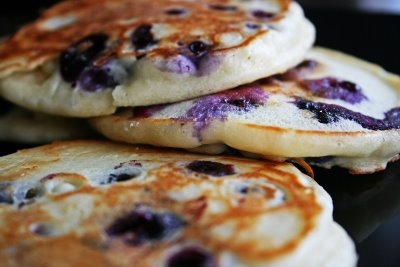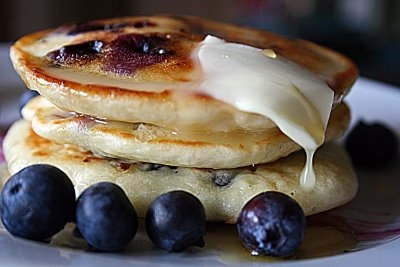
BLUEBERRY PANCAKES
INGREDIENTS
1 cup unbleached all-purpose flour
2 teaspoons granulated sugar
1/2 teaspoon table salt
1/2 teaspoon baking powder
1/4 teaspoon baking soda
3/4 cup buttermilk
1/4 cup milk (plus an extra tablespoon or so if batter is too thick)
1 large egg , separated
2 tablespoons unsalted butter, melted
1 cup blueberries
vegetable oil (for brushing griddle)
1. Mix dry ingredients in medium bowl. Pour buttermilk and milk into 2-cup Pyrex measuring cup. Mix yolk with melted butter, then stir into milk mixture. Whisk egg white in large bowl to stiff peaks. Dump wet ingredients into dry ingredients all at once; whisk until just mixed. Quickly fold egg white into batter. Fold blueberries into batter.
2. Meanwhile, heat griddle or large skillet over strong medium-high heat. Brush griddle generously with oil. When water splashed on surface confidently sizzles, spoon batter, about 1/4 cup at a time, onto griddle, making sure not to overcrowd. When pancake bottoms are brown and top surface starts to bubble, 2 to 3 minutes, flip cakes and cook until remaining side has browned, 1 to 2 minutes longer. Re-oil the skillet and repeat for the next batch of pancakes.
Recipe and pancake tips found on Cooks Illustrated.
Are there any tricks to making and serving great pancakes?
Hare some tricks we’ve found make for successful pancakes:Mix the Batter Lightly. There are two factors that promote fluffiness in pancake batter, underdeveloped gluten and dissolved baking soda. Gluten is a mix of very long proteins that are disorganized in structure. Once gluten is dissolved in water, these proteins can more easily rearrange their structure. Kneading or mixing gluten elongates the proteins and somewhat organizes them, an action similar to combing the strands of your hair. As the proteins start to lie more or less parallel to each other, the dough becomes elastic and less tender. By reducing the mixing time of your batter, you give the gluten less opportunity to organize.
Baking soda (either on its own or as part of the baking powder formula) creates the bubbles that make pancakes rise. When baking soda encounters an acid, carbon dioxide is formed to produce the bubbles in the batter. The stirring of the pancake batter speeds bubble formation by moving the baking soda and acid together. Unfortunately, stirring also causes the release of carbon dioxide gas by bringing formed bubbles to the surface of the mixture. Just a little too much stirring and the bubble-forming capacity of the baking soda will be quickly exhausted. To make the fluffiest pancakes possible, then, you should stir the batter until the ingredients are just incorporated—and not one stir more!
Use the Batter Within an Hour. To determine how far in advance we could make pancake batter, we mixed up a few batches of basic pancake batter and held them for different lengths of time before cooking: one hour, two hours, and three hours. Holding the batter for one hour had no detrimental effect on the pancakes. After two and three hours, however, the batter spread out too easily, producing thin, floppy cakes that were much less appealing than the ones made from fresh batter. Here’s why: In fresh pancake batter, baking powder reacts quickly, releasing most of its gas in a short period of time. The longer the batter sits, the fewer bubbles there are left when it’s time to cook, increasing the likelihood of flat flapjacks.
At first we thought we could add a bit more baking powder to the batter to provide some extra lift, but this merely lent an unpleasant chemical taste to the pancakes. Next, we tried adding a stiffly beaten egg white to the batter. The resulting pancakes were not quite as fluffy as those from fresh batter, but the egg white added a good amount of height. So the next time you find yourself with pancake batter past its prime, simply add a stiffly beaten egg white.
Heat the Pan Properly. The best way to determine when the skillet is ready is to make a test pancake the size of a half-dollar (use 1 tablespoon of batter). If after one minute the pancake is golden brown, the pan is ready. If the bottom of the pancake remains blond—or is close to burning—adjust the heat accordingly.
Serve as Soon as Possible. We tried several methods to determine how to hold pancakes before serving, from stacking up the pancakes on a heated plate, to covering them with foil, or to placing the plate of stacked pancakes in a warm oven. All of these methods did the job as far as keeping the pancakes warm. Even by the last batch of pancakes, the temperature reading would hit somewhere between 145 and 150 degrees. But these pancakes were compressed from being stacked, and they steamed from the heat and became very rubbery.
What we found that the best method was to spread the pancakes on a large cooling rack placed on a sheet pan (be sure to spray the cooling rack well with vegetable cooking spray and save yourself from sticking pancakes). Place the pan and the rack in a 200-degree oven and place your pancakes on the rack in a single layer, uncovered, for up to 20 minutes (or be warned-they will start to dry out.) The warm oven keeps the pancakes hot enough to melt a pat of butter, and leaving the pancakes uncovered keeps them from becoming soggy.
P.S..or you could sooooo cheat and use Bisquick and just add Blueberries! You can never go wrong with that!!!

It’s funny you know but I really appreciate that drip in the pancake picture. I also have a pancake recipe on my site with a blueberry sauce and let me tell you I waited for that drip what seems like forever. But when you capture it, it’s magical isn’t it?
Love it, love you.
I like the buttery drip too! Ha ha. Melted butter on pancakes? hello? Is this thing on? ::tap tap::
Lovely pancakes! That blueberry color is so lusciously intense it makes me want to run down and make pancakes with the blueberries sitting on my counter, right now.
These blueberry pancakes look absolutely perfect! Really pretty!
Those pancakes look really good! Great shot of the melting butter sliding off and dripping!
That, my dear is a money $hot…I’ll be right back, going to get some tissue, I’m salivating.
What a perfect shot. Another delicious recipe as usual, Leslie 🙂
oh, how i love action shots, especially ones of butter or caramel sauce. that’s a photo you can definitely be proud of!
i love pancakes, so i really appreciate all your tips here. goooood stuff, and i’m not kidding. 🙂
Aww, look at that colourful pancakes, looksuperb!!!
Great post and photo – and I agree with you about the methods for keeping pancakes warm!
Excellent shot! No stunt butter needed, it did its own stunts perfectly. Very nice post!
Fantastic action shot… how long did you have to sit there waiting, and waiting and waaaaaaaaaaaiting for that butter to driiiiiiip so perfectly?
Nice job!
Have a delicious day 🙂
I LOVE pancakes! Far more than any one person should love a food item. These look amazing!
Blueberries are the bomb! Your photographs are gorgeous!
Where is my fork?????????????? I love that butter melting and coming my way!…
I love blueberries!! The only thing I love more than blueberries are blueberry pancakes!!!
Thank you for the wonderful pic and great post!
Your pics make me so jealous!! 😀
oh, you taunt me with your creations. Look at that dripping, seductive butter. YUMMO!
love the action shot! blueberry pancakes are the best!
Mmm, those pancakes look so comforting!!
Wow, what an action shot! I love blueberry pancakes. 2nd only to banana pancakes!
These look like heaven in a pancake. I’d wake up to these pancakes seven days a week :). Lovely pics Leslie and thanks for the tips!
Hi Leslie,
We would like to feature your tips on Chef’s Tip. The best part is you don’t even need to register or sign up. Please email me at chefstip@gmail.com if interested. Thank you 🙂
Amy